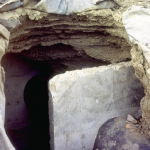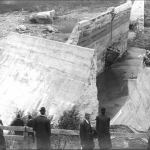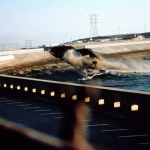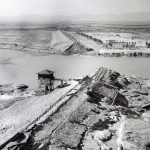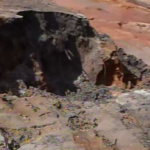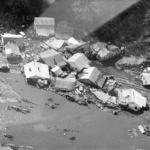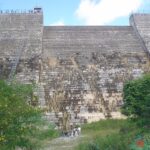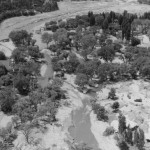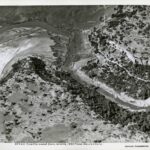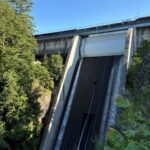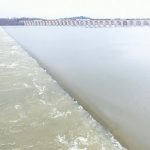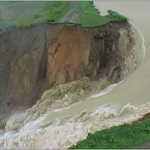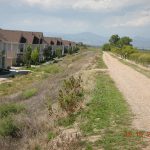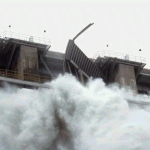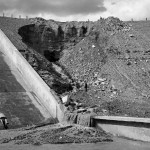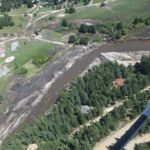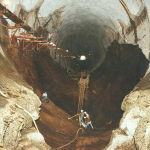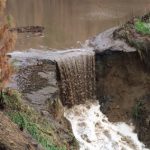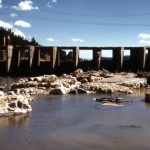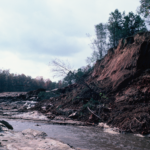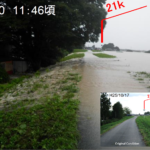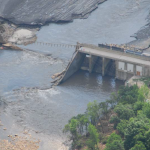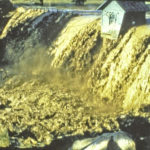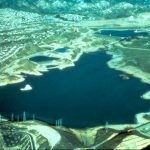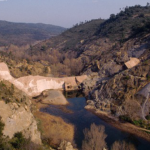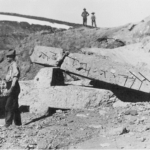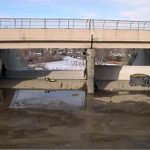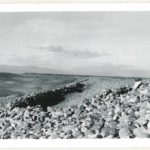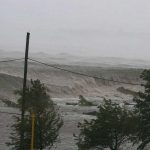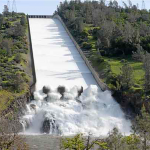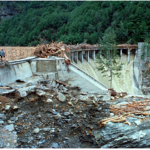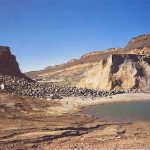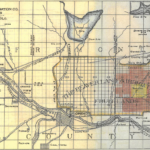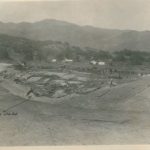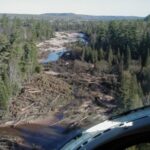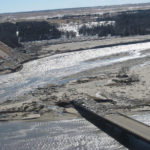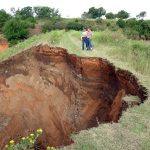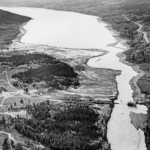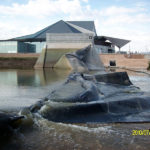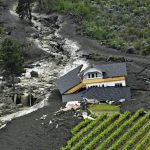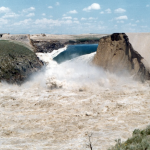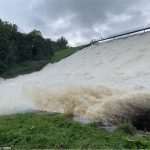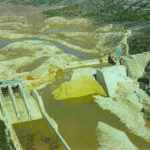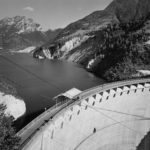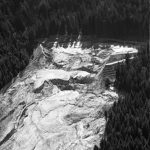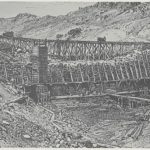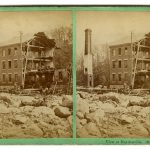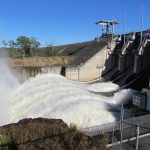Case Studies
Anita Dam (Montana, 1997)
Anita Dam is located about 22 miles north of Chinook, Montana, about 5 miles south of the Canadian border. The drainage, which normally flows only in response to snowmelt or heavy rain, is an unnamed tributary…
Learn More
Austin (Bayless) Dam (Pennsylvania, 1911)
Austin Dam (also known as Bayless Dam) was constructed between May and November of 1909 just outside Austin, Pennsylvania, a town of approximately 2,500 people in Potter County.
Learn More
Baldwin Hills Dam (California, 1963)
The Baldwin Hills Reservoir was constructed in 1951 to provide water to the south and southwest portions of the city of Los Angeles, California. Sitting atop one of the tallest hills in the region, the reservoir was confined on three sides by compacted earth dikes…
Learn More
Banqiao Dam (China, 1975)
Construction of Banqiao Dam began in April 1951 and was completed 14 months later, in June 1952. Constructed on the Ru River in Henan Province, China, it was part of a larger project to provide flood control, irrigation water, and electrical power to the region.
Learn More
Barahona No. 1 Dam (Chile, 1928)
Chile is probably the most seismically active country in the world, contributing a high percentage of total seismic energy released worldwide. Chile is also the world’s largest copper producer, generating 2.5 millions of tons of copper tailings each day. The failure of Barahona No. 1 dam in 1928 was the first record of an earthquake induced collapse of a tailings dam in Chile.
Learn More
Big Bay Lake Dam (Mississippi, 2004)
A number of the site conditions, design and construction details, and the distress indicators that developed between the initial reservoir filling and failure combine to suggest a complex internal erosion…
Learn More
Buffalo Creek Dam (West Virginia, 1972)
On February 26, 1972 at approximately 8:00 A.M., Coal Slurry Impoundment #3 at the Buffalo Creek coal mine in Logan County, West Virginia gave way sending millions of gallons of water and millions of cubic yards of coal slurry down the Buffalo Creek. Over the next three hours…
Learn More
Camará Dam (Brazil, 2004)
Camará Dam is a roller compacted concrete dam in Brazil completed in 2002 and failed during first filling in 2004. The dam was originally designed as an earthen embankment, but the design changed to RCC after the contractor was selected. Irregularities and potential conflicts of interest in the contracting process were allowed by the dam owner.
Learn More
Canyon Lake Dam (South Dakota, 1972)
The Friday afternoon of June 9, 1972 was the beginning of a tragedy for Rapid City, South Dakota along the eastern slopes of the Black Hills mountain range. Scattered showers from the previous days had left the ground saturated while a low-level air mass…
Learn More
Castlewood Canyon Dam (Colorado, 1933)
Castlewood Canyon Dam was constructed in 1890 across Cherry Creek, 40 miles southeast of Denver, Colorado. The masonry and rock-fill structure, built from local materials, was around 600 feet long with a height of 70 feet measured…
Learn More
Cleveland Dam (British Columbia, 2020)
Cleveland Dam is a concrete-gravity structure 300-feet-high with a crest 640-feet(or 195m) long. It is located in in North Vancouver, British Columbia, Canada. The dam impounds the Capilano Reservoir which is in one of three major Metro Vancouver watersheds that provide drinking water to the Greater Vancouver region.
Learn More
Columbia River Levees at Vanport (Oregon, 1948)
On May 30, 1948, rising floodwaters of the Columbia River breached a railroad fill acting as a levee and flooded the city of Vanport, Oregon. At the time, Vanport was Oregon’s second largest city and World War II’s largest federal housing project.
Learn More
Dock Street Dam (Pennsylvania)
Dock Street Dam is a run-of-the-river low-head dam located on the Susquehanna River in Harrisburg, Pennsylvania. The dam is a hollow reinforced concrete slab-and-buttress structure approximately 6 feet high, 3,460 feet long that creates a 3-mile lake with…
Learn More
Edenville Dam (Michigan, 2020)
Edenville Dam experienced a static liquefaction instability failure of its downstream slope on May 19, 2020. The resulting breach flow reached and overtopped the downstream Sanford Dam about 2-3 hours later, resulting in failure of that dam as well.
Learn More
El Guapo Dam (Venezuela, 1999)
Construction of El Guapo Dam began in 1975 and was completed in 1980. The dam is 197 feet tall and stores 114,000 acre-feet of drinking and irrigation water for the Barlovento Region in the state of Miranda, Venezuela. Because bedrock is deep…
Learn More
Equalizer Dam (Colorado)
The Equalizer Lake Dam is owned by the Greeley Loveland Irrigation Company and is located in Larimer County, Colorado approximately 50 miles north of Denver. The irrigation company operates and maintains a fifty mile long canal system, and four off channel reservoirs that supply water for agriculture…
Learn More
Folsom Dam (California, 1995)
Located approximately 20 miles northeast of Sacramento, California, Folsom Dam was designed and constructed by the U.S. Army Corps of Engineers to generate hydropower along the American River. The 340-foot high concrete gravity Folsom Dam along with two earthen wing dikes…
Learn More
Fontenelle Dam (Wyoming, 1965)
Fontenelle Dam is located on the Green River near La Barge, Wyoming and was originally built in 1964 to provide irrigation water and hydropower for a region of southwest Wyoming. The earthfill embankment structure…
Learn More
Fort Peck Dam (Montana, 1938)
Beginning at about 1:15 pm on September 22, 1938, the upstream slope of the dam adjacent to the right abutment experienced a large failure as the construction work had progressed to within 20 feet of the final dam crest elevation. One hundred eighty men were working in the area.
Learn More
Front Range Flood (Colorado, 2013)
The September 2013 rainfall that occurred on the Front Range of Colorado was the result of an unusual, late season storm event where warm moisture and upslope winds allowed this regional storm to dump up to 17 inches of rain over a seven day period.
Learn More
Fujinuma Dam (Japan, 2011)
On March 11, 2011, a massive 500-600 km rupture off the east coast of Japan resulted in a powerful Magnitude 9.1 earthquake and subsequent tsunami. The shaking also damaged at least 745 dams in Fukushima Prefecture and caused a rare seismically induced failure of Fujinuma Dam.
Learn More
Glen Canyon Dam (Arizona, 1983)
The United States Bureau of Reclamation (Reclamation) began construction of Glen Canyon Dam in 1956 as a part of the Colorado River Storage Project to provide water storage, flood control, and hydropower to Arizona, Colorado, Wyoming, Utah, and New Mexico.
Learn More
Guajataca Dam (Puerto Rico, 2017)
Guajataca Dam is a 121 ft high, 1,037 ft long, high hazard potential earthen embankment structure constructed using semi-hydraulic fill methods for the central core (i.e., “puddle” core) and rolled and compacted outer shells composed of a mixture of clayey soils, gravel, and cobbles.
Learn More
Hawkins Dam (Washington, 2014)
Hawkins Dam impounded the most downstream reservoir in the Wenner Lakes chain of manmade lakes located 6 miles Southeast of Twisp WA in Okanogan County. Hawkins Dam Impounded Wenner Lake No. 1. Hawkins Dam is a 35-foot high earthfill dam with a crest length of 350 feet and impounds a 4-acre reservoir with a volume of 22 acre-feet…
Learn More
Hebgen Dam (Montana, 1959)
Just before midnight on August 17th 1959 in southwest Montana, in the vicinity of Yellowstone National Park, a Mw 7.3 earthquake caused an estimated 36 to 43 million cubic yard rockslide to rapidly cross the Madison River and continue up the opposite canyon…
Learn More
Ka Loko Dam (Hawaii, 2006)
At approximately 5 a.m. on March 14, 2006, following a four-week period of heavy rainfall, Ka Loko Dam experienced an unexpected, catastrophic, and massive breach that quickly drained nearly the entire reservoir.
Learn More
Kelly Barnes Dam (Georgia, 1977)
Kelly Barnes Dam was located approximately a half mile upstream (north) of Toccoa Falls Bible College in Stephens County, Georgia. Toccoa Falls, a 186-foot-high waterfall, was located between the dam and the college. The dam site was originally the location…
Learn More
Kinugawa Levee at Joso (Japan, 2015)
Beginning around September 6, 2015, Tropical Storm Etau together with Tropical Depression Kilo began dropping excessive rainfall across northeast Japan. The interaction of the two systems caused them to stall and concentrate rainfall in a narrow band over the Kinugawa watershed.
Learn More
Lake Delhi Dam (Iowa, 2010)
Lake Delhi Dam was originally constructed by the Interstate Power Company between 1922 and 1929 for hydroelectric power generation. The dam is located in Iowa approximately 1.4 miles south of Delhi on the Maquoketa River and impounds the nine-mile-long Lake Delhi. Reaching a maximum height…
Learn More
Langley Dam (South Carolina, 1886)
The failure of Langley Dam, located near Aiken, South Carolina, is one of the more noteworthy and surprising far field effects of the M7.0, August 31, 1886, Charleston, SC earthquake…
Learn More
Laurel Run Dam (Pennsylvania, 1977)
Constructed between 1915 and 1918, Laurel Run Dam was a rockfill dam erected across Laurel Run near Johnstown, Pennsylvania. It was built to replace a smaller dam in order to provide water for drinking and industrial needs…
Learn More
Lawn Lake Dam (Colorado, 1982)
Lawn Lake Dam was located in Rocky Mountain National Park upstream of Estes Park, Colorado. It was an embankment dam and constructed in 1903 and owned by an irrigation company. It fell within the National Park Boundary…
Learn More
Little Deer Creek (Utah, 1963)
Little Deer Creek Dam and Reservoir were conceived as part of the Kamas Water Project and were owned by the South Kamas – Washington Irrigation Company. The dam was designed by the Utah Water and Power Board that also oversaw construction.
Learn More
Lower San Fernando Dam (California, 1971)
The Lower San Fernando Dam (LSFD) was built by the Los Angeles Bureau of Water Works and Supply (predecessor of Los Angeles Department of Water and Power (LADWP)) as part of the terminal storage system for the Los Angeles Aqueduct that included the adjacent Upper San Fernando Dam and several other dams in southern California.
Learn More
Machhu Dam II (Gujarat, India, 1979)
On August 10, 1979, monsoon storms poured over Gujarat, India. Monsoon rainstorms were not uncommon in this part of India, but as the storm increased it was clear this was larger than the usual storm. Flow began to increase down the Machhu river, first hitting Machhu Dam I and then turning downstream to Machhu Dam II…
Learn More
Malpasset Dam (France, 1959)
Malpasset Dam was a concrete arch dam located on the Riveria in the Cannes District near Fréjus, in Southern France. Exhibiting curvature in both the plan and section directions, the double-curvature arch structure spanned the Reyran River. At the time of completion in 1954, it was reported…
Learn More
Mammoth Dam (Utah, 1917)
In 1902 the Price River Irrigation Company proposed to build a dam on Gooseberry Creek about 80 miles SE of Salt Lake City, UT. It would be an earthfill structure with a height of 100 feet. An outlet tunnel through bedrock…
Learn More
Maple Grove Dam (Colorado, 1979)
In an effort to increase water storage capacity and provide flood protection to the surrounding communities of Lakewood, Colorado, two inflatable Fabridams were added to the crest of Maple Grove Reservoir and spillway in 1977. Shortly before midnight…
Learn More
Marshall Lake Dam (Colorado)
Routine inspections of Marshall Lake Dam in the early 21st century were relatively uneventful. The 75-foot-tall, 2,400-foot-long high hazard earth embankment dam had relatively flat slopes…
Learn More
Meadow Pond Dam (New Hampshire, 1996)
Lynda Sinclair died on March 13, 1996, at the age of 48. She drowned trying to escape the flood torrent caused by the failure of Meadow Pond Dam in her town of Alton, New Hampshire (see Fig. 1 for location). However, the series of circumstances that led to her death…
Learn More
New Orleans Levee System (Louisiana, 2005)
A sprawling collection of levees of varying size, construction, and ownership were constructed in the Mississippi delta near New Orleans over a period of over 200 years, mostly on low land reclaimed from the salt marshes and bayous, but some like the higher sandbar deposits in the “Crescent” where the downtown area was developed.
Learn More
Oroville Dam (California, 2017)
With a height of 770 feet, Oroville Dam is the tallest dam in the United States. Completed in 1968 and located north of Sacramento in the foothills of the Sierra Nevada mountains, this large earthfill embankment dam is owned by the California Department of Water Resources (DWR) and is one of the key features…
Learn More
Palagnedra Dam (Switzerland, 1978)
Palagnedra Dam was constructed between 1950 and 1952 on the Melezza River located in the country of Switzerland. Palagnedra Dam is a 72-meter tall, 120-meter long, concrete gravity arch dam, primarily constructed for hydropower.
Learn More
Penn Forest Dam (Pennsylvania, 1994)
Penn Forest Dam was constructed between 1956 and 1958 to be one of the main water supply reservoirs for the city of Bethlehem, Pennsylvania. The dam was originally an earthfill embankment structure, stood 145 feet high, 1,930 feet long, and stored 6.4 billion gallons of water…
Learn More
Prospect Dam (Colorado, 1980)
Prospect Reservoir Dam is owned by the Henrylyn Irrigation District (District) and is located in Weld County (County), Colorado approximately 40 miles northeast of Denver. The District operates and maintains a fifty mile long canal system, 4 reservoirs, and several hundred miles of…
Learn More
Quail Creek Dike (Utah, 1989)
Quail Creek Reservoir, located in Washington County Utah, is an approximately 40,000 acre-feet water storage project for irrigation, municipal, and industrial use. Design of the project was completed in 1983 with construction beginning in November of that year. The project consisted of…
Learn More
Santa Clara Dam (Utah, 2012)
In early September 2012, a series of rainstorms moved across southwestern Utah. In the city of Santa Clara, a debris basin formed by the Santa Clara Dam had filled and drained during these storms without issue. On the morning of September 11, another rainstorm passed through the area.
Learn More
Schaeffer Dam (Colorado, 1921)
Pioneers began settling in present-day Penrose in the early 1860’s. The Town of Penrose, Colorado is upstream of the confluence of Beaver Creek and the Arkansas River, located 25 miles west of Pueblo. Settlements began along the banks of Beaver Creek.
Learn More
Sheffield Dam (California, 1925)
Sheffield Dam was built in late 1917 in a ravine referred to as Sycamore Canyon, north of the City of Santa Barbara, California. Constructed as a distribution reservoir for the Santa Barbara Municipal Water Department, the dam was named after Eugene Sheffield, one of the City’s first water commissioners…
Learn More
Silver Lake Dam (Michigan, 2003)
The emergency fuse plug spillway at Silver Lake Dam in Michigan failed on May 14, 2003, resulting in a nearly complete release of the reservoir. The dam was modified in 2002 to increase spillway capacity with construction of the fuse plug spillway.
Learn More
South Fork Dam (Pennsylvania, 1889)
South Fork Dam was an earth- and rock-fill dam located about 8 miles east of Johnstown, PA. Originally constructed in 1852, the dam’s primary purpose was to provide a source of water for a division of the Pennsylvania Canal. The dam was approximately 72 feet high…
Learn More
Spencer Dam (Nebraska, 2019)
Spencer Dam was a dam constructed for hydropower in 1927 on the Niobrara River in northern Nebraska. The dam consisted of a 3,200-foot-long embankment section and a 500-foot-long powerhouse/spillway section. The dam’s maximum height was 26 feet.
Learn More
St. Francis Dam (California, 1928)
Located approximately forty miles northwest of Los Angeles, California, St. Francis Dam was a curved concrete gravity dam constructed between 1924 and 1926 in order to provide a storage reservoir for the Los Angeles Aqueduct system…
Learn More
Sugar Creek Watershed Dam No. L-44 (Oklahoma, 2007)
Sugar Creek Watershed Dam No. L-44 (Sugar Creek Dam) is located approximately four miles northwest of Anadarko in Caddo County, Oklahoma. It is one of 51 flood control dams in the Sugar Creek watershed.
Learn More
Swift and Two Medicine Dams (Montana, 1964)
The second week of June 1964 brought one of the worst natural disasters in Montana’s recorded history. In all, the flooding caused 30 deaths, upwards of $60M in damages…
Learn More
Taum Sauk Dam (Missouri, 2005)
Taum Sauk Pump Storage Plant was constructed by Union Electric in Reynolds County, Missouri between 1960 and 1962 to provide a means of hydroelectric power generation during peak demand periods. The plant consisted of an Upper Reservoir situated atop Proffit Mountain…
Learn More
Tempe Town Lake Dam (Arizona, 2010)
Historically, the Salt River was a perennial source of water to the early residents of the Phoenix Valley. With a drainage area of nearly 13,000 square miles, the river provided many benefits to the area including water for irrigation and recreation during the very hot summer months. However, the river also proved to be an unpredictable flooding hazard, and would periodically experience major floods that washed out roads and bridges, including the railroad bridge in the late 1800’s and Mill Avenue Bridge in the 1990’s.
Learn More
Testalinden Dam (British Columbia, 2010)
Testalinden Dam was constructed in the 1930’s at the headwaters of Testalinden Creek at 1,810 m elevation near the summit of Mount Kobau, approximately 1,500 m above the Okanagan River valley below (see figures). The 2.5 m high dam was constructed…
Learn More
Teton Dam (Idaho, 1976)
Teton Dam was located in southeastern Idaho about 15 miles from Rexburg in the valley of the Teton River. The dam and its reservoir were the principal elements of the Teton Basin Project designed by the Bureau of Reclamation to control flooding as well as provide a source of…
Learn More
Toddbrook Reservoir Dam (England, 2019)
Toddbrook Reservoir is located just upstream of the town of Whaley Bridge in the High Peak area of Derbyshire, England. The almost 80-foot tall embankment was constructed between 1837 and 1840 for water supply, with a central puddle core and outer shells of more granular earthfill.
Learn More
Tous Dam (Spain, 1982)
Tous Dam is located in the Province of Valencia in the southeast corner of Spain, near the Mediterranean Coast. The dam is the last flood control structure on the Júcar River Basin, an 8,340-square-mile drainage. The Júcar River Basin ranges dramatically between sea level…
Learn More
Vajont Dam (Italy, 1963)
Vajont Dam is a double-curved, thin-arch dam, and at 860 feet high, it remains one of the tallest dams in the world. The dam is 11 feet wide at the crest, 73 feet wide at the base, with a crest length of 623 feet. There are 16 gates on the crest with an underground powerhouse…
Learn More
Val di Stava Dam (Italy, 1985)
Mining in the area around Mount Prestavèl in northeastern Italy dates to the sixteenth century and the extraction of argentiferous galena (a mineral of sulfur and lead). By 1934, fluorite had become the focus of mining in the area. In 1961, the mine operator at Val di Stava switched from a gravimetric system to a froth flotation process to separate the minerals from waste and constructed a new fluorite plant.
Learn More
Walnut Grove Dam (Arizona, 1890)
Walnut Grove Dam was constructed at a site approximately 20 miles northeast of Wickenburg, Arizona. Gold had been discovered in the area and a New York Investor, Wells H. Bates, wanted a dam built in order to supply water for hydraulic mining.
Learn More
Williamsburg Reservoir Dam (Massachusetts, 1874)
The Mill River in western Massachusetts typified the New England hydrologic resources used by 19th century industry, and the valley development was like that along hundreds of other rivers around New England. The river is a tributary of New England’s largest river, the Connecticut…
Learn More
Wivenhoe Dam (Australia, 2011)
Wivenhoe and Somerset Dams are situated on the Brisbane River in Queensland, Australia, with a total catchment area of 2,710 square miles. Somerset Dam is located upstream of Wivenhoe Dam with a drainage of 520 square miles. The Dams are operated as water supply and flood control reservoirs by Seqwater, the Queensland Government Bulk Water Supply Authority.
Learn More

